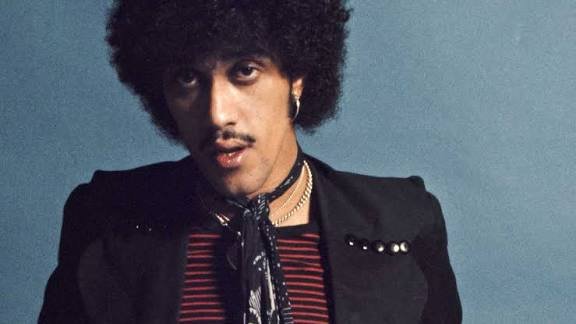Phil Lynott, the legendary frontman of Thin Lizzy, remains one of rock’s most revered figures. Known for his distinctive voice, captivating stage presence, and deep influence on the genre, Lynott’s legacy continues to inspire generations of musicians and fans alike. His untimely death, at the age of just 36, left a void in the rock world that has never truly been filled. Yet, despite his early departure, Phil Lynott’s impact on music, culture, and his fans remains immense. In this article, we will delve into the life of Phil Lynott, his musical contributions, and the indelible mark he left behind, examining the man, the musician, and the legacy that continues to shine.
The Life of Phil Lynott: A Journey from Dublin to Global Stardom
Born on August 20, 1949, in West Bromwich, England, but raised in Dublin, Ireland, Phil Lynott’s early life was a mix of challenges and opportunities. Raised by his mother, Phil’s father, Cecil Lynott, was absent from his life, something that Phil would later explore in his music. His mother, Philomena, provided him with the stability and love that would fuel his passion for music.
Lynott’s early exposure to music came through his love for rhythm and blues, jazz, and rock. He picked up the guitar at a young age, and by his teenage years, he was already dreaming of becoming a rock star. In 1969, he formed the band Thin Lizzy, which would become his musical vehicle to superstardom. Over the years, the band evolved from a modest act to one of the most influential rock bands of the 1970s, with Lynott as the charismatic lead singer, bassist, and primary songwriter.
The Rise of Thin Lizzy
Thin Lizzy, originally formed in Dublin, gained a reputation for their energetic performances and unique sound, blending hard rock with elements of traditional Irish music. Lynott’s songwriting was inspired by his life experiences, from his troubled relationship with his father to his observations on life, love, and rebellion. One of the most notable elements of Thin Lizzy’s success was Lynott’s ability to write songs that connected emotionally with listeners. Hits like “The Boys Are Back in Town,” “Whiskey in the Jar,” and “Jailbreak” became anthems that defined the band’s legacy.
In the early 1970s, Thin Lizzy started gaining international attention. Their distinct sound, which mixed hard rock with melodic elements and Lynott’s poetic lyrics, set them apart from many of their contemporaries. Phil Lynott’s stage presence and personal charisma made him the heart and soul of Thin Lizzy. With his signature long hair, leather jackets, and confident persona, Lynott became a symbol of rock rebellion and individuality.
Phil Lynott’s Music: A Master of Storytelling
Lynott’s music transcended typical rock fare. His lyrical themes were diverse, covering personal struggles, the human condition, love, loss, and his connection to Ireland. Songs like “Dancing in the Moonlight” and “Sarah” displayed his softer side, while tracks like “Black Rose” and “The Rocker” showcased his raw energy and rebellious spirit. He was, and still is, regarded as one of rock’s greatest songwriters.
Lynott’s contributions to rock music weren’t just limited to his own band. He was a prolific songwriter, collaborating with other artists and contributing to the development of the Irish rock scene. His influence reached far beyond Thin Lizzy, inspiring countless bands and musicians, from Metallica to U2, all of whom cite Lynott as a significant influence.
The Tragic End: Phil Lynott’s Death and Its Impact
Phil Lynott’s untimely death on January 4, 1986, shocked the world and left a deep void in the music community. His passing was a result of heart failure, compounded by his struggles with drug addiction. He had been in and out of hospital for several months due to his deteriorating health, which was a direct result of his lifestyle choices.
Lynott’s death was tragic not only because of his young age but because it marked the end of an era in rock music. Thin Lizzy had been on the brink of releasing another album, and Lynott’s vibrant presence was no longer a part of the music world. Fans around the globe mourned the loss of a man who had given so much to the rock scene.
How Did Phil Lynott Die?
Phil Lynott’s death was attributed to complications from heart failure, brought on by a combination of factors, including his long battle with drug and alcohol abuse. It was a sad and premature end to a promising life and career, one that left many unanswered questions about what could have been had he lived longer.
Phil Lynott’s death also raised awareness about the dangers of substance abuse, and it highlighted the dark side of fame that many musicians struggle with. It was a painful reminder that even the most talented and successful artists are not immune to the struggles of mental health and addiction.
Phil Lynott’s Legacy: More Than Just a Musician

While Phil Lynott’s death marked the end of his musical career, it certainly did not mark the end of his influence. His legacy continues to live on through his music, his contributions to rock and roll, and the impact he had on future generations of musicians.
The Phil Lynott Statue: A Lasting Tribute
In 2005, a statue of Phil Lynott was erected in Dublin, Ireland, in tribute to his incredible contributions to music and his cultural impact. Located in the heart of the city, the statue stands as a lasting reminder of Lynott’s legacy and the cultural significance of Thin Lizzy. The statue depicts Lynott holding a bass guitar, his signature instrument, and is one of the most iconic landmarks in Dublin.
Phil Lynott’s Family: The People Behind the Icon
Lynott’s family played an important role in his life, and they remain integral to his legacy. His mother, Philomena Lynott, was a constant source of support for him, and she was deeply involved in preserving his legacy after his death.
Lynott’s relationship with his father, Cecil, was strained, and he often referenced his father’s absence in his songs. However, despite the tension in their relationship, it was clear that the absence of his father affected Lynott deeply.
Phil Lynott wife, Caroline Crowther, whom he married in 1982, was also an important figure in his life. Their relationship was a deeply personal one, and their bond was evident in Lynott’s music. Tragically, they had only been together for a short time before his death.
Lynott’s children, including his daughters, Sarah and Cathleen, continue to honour his memory. His daughters, like their father, have been involved in music and the arts, keeping his legacy alive. It’s often been a subject of speculation whether Lynott knew about his son, as he had a child outside of his marriage, but the truth remains somewhat murky.
Phil Lynott Music: A Timeless Legacy
Phil Lynott’s songs remain timeless. Even decades after his death, his music still resonates with listeners around the world. His ability to blend poetic lyrics with hard-hitting rock music created a unique sound that has influenced countless artists. From Thin Lizzy’s most famous hits like “The Boys Are Back in Town” and “Jailbreak” to his solo work, Lynott’s music continues to inspire both old and new fans alike.
Karron Eubank: The Untold Story of Chris Eubank’s Ex-Wife
A Selection of Phil Lynott’s Most Iconic Songs
| Song Title | Year Released | Album |
|---|---|---|
| The Boys Are Back in Town | 1976 | Jailbreak |
| Whiskey in the Jar | 1972 | Vagabonds of the Western World |
| Jailbreak | 1976 | Jailbreak |
| Dancing in the Moonlight | 1977 | Bad Reputation |
| Black Rose | 1979 | Black Rose |
The Phil Lynott Statue: A Symbol of His Enduring Influence
The Phil Lynott statue in Dublin is not just a tribute to the man, but a symbol of the enduring power of his music. Located in the vibrant cultural centre of Dublin, the statue has become a pilgrimage site for fans worldwide. Each year, thousands gather to pay their respects to the man who changed rock music forever.
Key Facts About the Phil Lynott Statue
| Fact | Details |
|---|---|
| Location | Harry Street, Dublin, Ireland |
| Unveiled | 2005 |
| Statue Design | Lynott holding a bass guitar |
| Significance | Tribute to Phil Lynott’s musical legacy |
The Lasting Influence of Phil Lynott
Phil Lynott’s legacy is a testament to the power of music and its ability to transcend time. His contributions to rock and roll continue to inspire new generations of musicians. From his distinctive voice to his unique songwriting style, Lynott’s influence can still be heard in today’s music.
His ability to blend personal struggles with universal themes made his music relatable, and it is no wonder that he remains one of rock’s most enduring icons. His story is one of triumph, tragedy, and undeniable talent. The legacy of Phil Lynott continues to live on, not just in his songs, but in the hearts of all those who loved him and his music.
Conclusion
Phil Lynott’s life and career were far too short, but his impact on music and culture is immeasurable. From his humble beginnings in Dublin to his rise as the frontman of Thin Lizzy, Lynott’s journey is one that continues to resonate with fans across the globe. His untimely death was a tragic loss, but his music, his story, and his legacy live on. As long as Thin Lizzy’s songs play on the radio, as long as the statue of Phil Lynott stands in Dublin, and as long as his influence is felt by new generations of musicians, Phil Lynott will remain a rock icon for all time.
Phil Lynott: The Legacy of a Rock Icon is a tribute not only to the man himself but to the timeless music that continues to inspire. Whether you are a longtime fan or a newcomer to his music, the legacy of Phil Lynott is one that will continue to shine brightly for many years to come.
Disclaimer: The content provided in this article is for informational purposes only. While we strive for accuracy and reliability, we cannot guarantee the completeness or correctness of the information. Any references to Phil Lynott, his life, or his legacy are based on publicly available sources and personal interpretations. We encourage readers to verify facts and seek professional advice where necessary.









